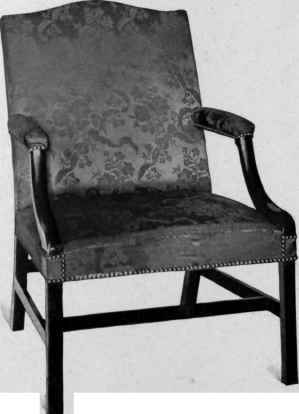The Period Of The Cabinet-Makers, 1750-1840. Part 8
Description
This section is from the book "Colonial Furniture In America", by Luke Vincent Lockwood. Also available from Amazon: Colonial Furniture In America.
The Period Of The Cabinet-Makers, 1750-1840. Part 8
The upholstered chairs that are most frequently found in England and here are of the types following.
Figure 582 shows an earlier upholstered chair of the Chippendale period, as indicated by its high back, curved seat, and bird's claw and ball feet and shell carving on the knees. It is the property of Mr. Dwight Blaney, of Boston.
Another form of upholstered chair is shown in Figure 583 and is what would he called in French a bergere. The legs are cabriole, terminating in French scroll feet, with a cabochon, scrolls, and leaves carved on each knee. The back legs arc .also cabriole and raked, and terminate in Dutch feet with a slight leaf carving. This chair is the property of the writer.
Figure 584 shows the simplest form of Chippendale upholstered chair most commonly found in this country. They are often made in sets with side chairs to match. The arms are upholstered and the supports are raked on a curve. The legs and stretchers are perfectly plain. This chair is the property of the writer.
The Hepplewhite, Shearer, and Sheraton styles did not immediately follow the Chippendale and Adam styles, but there was a period of transition in which the two were harmonised. As before stated, this transition, however, took place during the years of our Revolutionary War, with the necessary result that these pieces did not come here; but the cabinet-makers in this country jumped from the Chippendale into the Hepplewhite and Shearer styles without the intervening transition pieces. This probably accounts largely for the great number of plain, straight-leg Chippendale chain found here.

Figure 583. Upholstered Chair in Chippendale style, 1760-70.

Figure 584. Upholstered Chair in Chippendale style, 1770-80.
A few transition pieces are however found, one of which is in Figure 585. The top rail is in the shield shape of the Hepplewhite school, but the stiles are extended through the seat to form the rear legs, and the splat is shaped as it was in the Chippendale period. A number of chairs like this have been found in and about Hartford, Connecticut, and in a table of prices published by the joiners of Hartford, in 1792, we find advertised "A chair with urn'd banisters" which could be made for £1 9s. This probably referred to this design of chair.
Figure 586 shows an arm and side chair in transition style which belong to Mrs. N. E. Church, of Belmar, New Jersey. The stiles curve into the top, which is depressed at the centre, and the surfaces are well moulded. The splat is pierced in the anthemion design inverted. At the top is a festoon of leaves. The front rail is both hollowed and serpentine and the legs are tapering, with spade feet.

Chair in transition style, about 1790.

Chairs in transition style, 1780-90.
The regulation shield-backed Hepplewhite chair is shown in Figure 587. This form of construction is faulty because the centre of the back is not fastened to the seat rail. It is finished with four reeded and carved flat spindles setting into a half-rosette. The legs are reeded and terminate in spade feet. This chair is the property of Mr. H. W. Erving.
Figure 588 shows another form of the shield back the centre of which is filled in with three supporting stems with flowers. The legs are tapering and plain.

Chair in Hepplewhite style, 1785-95.
Still another shield-back Hepplewhite chair is shown in Figure 589. At the centre of the back is an urn with streamers and the usual half-rosette is at the base.
A very beautiful shield-shaped Hepplewhite chair is shown in Figure 590. The centre design is drapery caught up at three places and a fleur-de-lis is at the top. The legs taper and terminate in spade feet. The seat is upholstered over the edge and finished with brass-headed nails.
Figure 591 shows another shield-shaped Hepplewhite chair. The design is drapery caught at two ends and passing over an inlaid medallion. Below are carved foliated scrolls and acanthus leaves. The arms and supports are in graceful scrolls. This chair is the property of the writer.

Figure 588. Chair in Hepplewhite style, 1785-95.

Chair in Hepplewhite style, 1785-95-.

Chair in Hepplewhite style, 1785-95.
Figure 592 shows a very beautiful shield-shaped Hepplewhite chair in the Pendleton Collection. The back consists of three conventionalised lilies from the spathes of which are streamers of grass and heads of wheat. The legs are tapering, reeded and fluted, terminating in spade feet.

Figure 591. Chair in Hepplewhite style, 1785-95.

Chair in Hepplewhite style, 1785-95.
Continue to:


